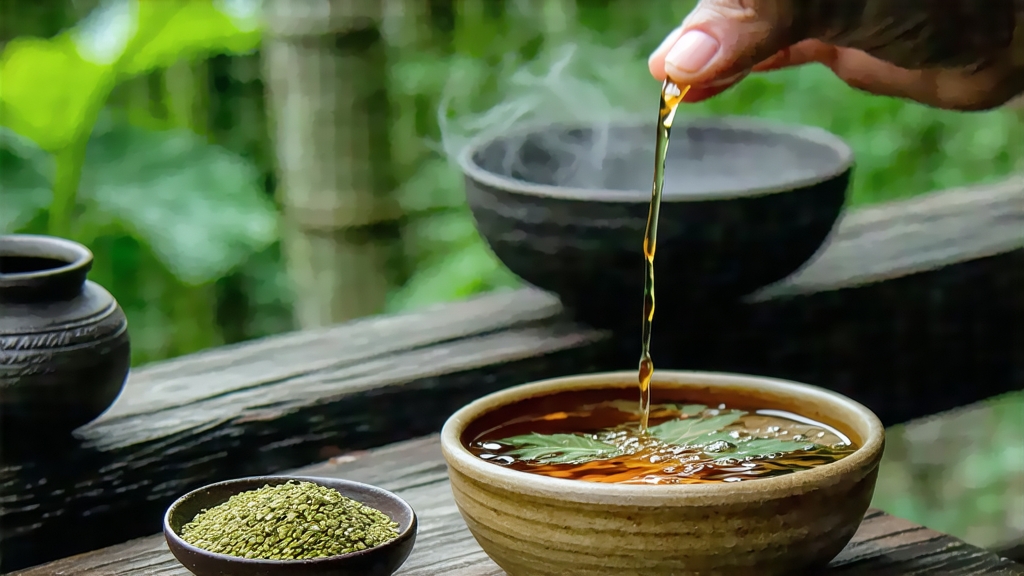
Tie Guan Yin, literally “Iron Goddess of Mercy,” is the most aromatic envoy of Chinese oolong tea. Born in the granite soils of Anxi, Fujian, it balances on a knife-edge between green freshness and roasted depth, seducing novices and scholars alike with every lilac-scented sip. To understand China’s tea imagination, one must first listen to the legend of an iron statue that wept a single tear and turned a forgotten bush into liquid jade.
Legend & History
Folklore places the birth of Tie Guan Yin during the Yongzheng era (1723–1735). A poor farmer named Wei Yin, devout to Guanyin, the Bodhisattva of Compassion, found a withered tea shoot beside her rust-colored iron effigy in Xiping village. He replanted it in his field, and the next spring the leaves exuded an aroma so haunting that villagers believed the goddess had infused her mercy into the tree. By the late 18th century the Qing court listed “Ti Kuan Yin” among its tribute teas; caravans carried it across the Tea Road to Tibet, Russia, and finally to London parlors where Victorian hostesses marveled at its “orchid breath.” In 1915 a Xiping sample won gold at the Panama-Pacific Exposition, sealing its global reputation. Today Anxi County harvests 60,000 tons yearly, yet the finest grades still come from the original 800-meter red-soil core known as “Ganyu Cha District,” where morning mist and afternoon sun create the 10 °C diurnal swing that locks in floral esters.
Cultivars & Micro-terroirs
Tie Guan Yin is both a tea name and a clonal cultivar (Camellia sinensis var. sinensis ‘Tie Guan Yin’). Within Anxi, three micro-terroirs express distinct personalities. Xiping village produces the classical “eight-infusions orchid” style: delicate, creamy, with a returning sweetness called yun gan hui—literally “sweet throat memory.” Gande township, higher and cooler, yields a greener, more vegetal profile reminiscent of fresh snap peas. Xianghua township, sheltered by granite cliffs, gives mineral-driven leaves that tolerate heavier charcoal roasting. Beyond Fujian, migrants have transplanted the cultivar to Taiwan’s Muzha and China’s Wuyi foothills, but connoisseurs insist only Anxi’s diurnal fog and iron-rich laterite can coax the cultivar’s signature “ringing” finish—a high-pitched floral note that lingers like a temple bell.
Crafting the Iron Goddess
Tie Guan Yin is the most labor-intensive Chinese oolong, passing through exactly 24 procedural hours that read like choreography. Picking begins at dawn when two leaves and a bud are still taut with overnight dew; any later and solar stimulation converts floral linalool into harsher geraniol. The leaves are sun-withered for 20 minutes, just until the edges feel like parchment, then moved indoors to conditioned troughs where they are tossed, bruised, and rested in cycles that last from midnight to sunrise. This yao qing—“rocking the green”—is the moment of oxidation. Masters read the leaf like a pulse: when the outer rim turns coral and the center remains jade, oxidation is arrested. A 260 °C tumble in a rotating drum kills the enzymes within 90 seconds, locking in the 30–40 % oxidation that defines oolong. Next comes the unique “wrap-balling” step: leaves are wrapped in white cotton squares and hand-rolled under hardwood boards, 100 times per parcel, 12 parcels per batch. The pressure fractures cell walls, releasing aromatic oils that polymerize into the tea’s signature amber liquor. After a low-temperature bake at 70 °C for three hours, the crude maocha is ready. Traditionalists then subject the tea to a slow charcoal roasting over lychee wood embers for 30–40 hours across two months, creating the “nong xiang” (roasted aroma) style; modern green-style skips roasting, preserving electric-green color and gardenia notes.
Grading Language
Anxi traders use a shorthand of numbers and metaphors. “33” means third picking season, third grade leaf; “AAA” is purely marketing. Serious buyers look for three tactile clues: the sound of dry leaf—premium grades rustle like iron flakes;